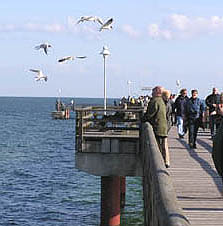|


German,
Standard German variety (“High German”)
North-German-colored
 Because
of certain speech characteristics, most
Because
of certain speech characteristics, most
North Germans are fairly
easily told apart even
when they speak Standard German. But these
echoes from ancestral Low Saxon (Low
German) are now fading away. |
Language
information: Many North German varieties fall into the Standard German range but are variously
northern-colored, sound and read very distinctively northern to German speakers
outside Northern Germany. This is mostly due to Low Saxon (Low German) substrates.
However, in most urban settings the shift from Low Saxon to Standard German
was not direct. These varieties developed from hybrids known as Missingsch. In other words they may be considered “cleaned-up” Missingsch in which more or less Missingsch influences remain, influences that
ultimately go back to Low Saxon.
Among commonly encountered
Low-Saxon-derived features of Northern German found in the sample presented here
are the following:
-
avoidance
of preterite forms (e.g., perfective hat sein Nest im Wagenschuppen gehabt versus more neutral standard preterite hatte sein Nest im Wagenschuppen ‘had his nest in the car shed’)
-
use
of originally demonstrative das (neuter ‘that’) in place of personal es ‘it’ in areas where Low Saxon has replaced older et or it with dat,
-
tendency
toward using originally demonstrative der (masculine ‘that’), die (feminine ‘that’) in place of personal er and sie respectively,
-
tendency
toward using “split” adverbs,
much as in English (e.g., da haben wir uns so vor verjagt versus standard davor haben wir uns so erschrocken ‘that scared us so’, cf., Low Saxon daar hebbt wi us so vör verjaagt),
-
frequent
doubling of adverbial expressions (e.g.; wie er um die Ecke rum kommt versus standard als er um die Ecke kam ‘as he came around the corner’),
-
tendency
toward using the present tense in narratives,
-
omission
of -e in first person verb forms (e.g., ich krieg versus standard ich kriege ~ ich bekomme ‘I get’, ‘I am getting’, ‘I will get’),
-
frequent
use of wie in place of standard als ‘as’, ‘when’, ‘than’ (cf. Low Saxon as ‘like’, ‘as’, ‘when’, ‘than’, Standard German wie ‘like’, ‘as’, als ‘when’ (past), ‘than’, wenn ‘when’ (non-past)),
-
Low-Saxon-determined
choice of words (e.g., daar > da versus standard da ~ dort ‘there’),
-
frequent
use of Low Saxon calques (i.e., translated loanwords; e.g., afblieven > abbleiben versus standard bleiben ‘to get to’, langs > lang(s) versus standard entlang ‘along’, doll ‘crazy’ > doll versus standard arg, sehr, stark ‘strongly’, ‘hard’), aflehren > ablehren versus standard abgewöhnen, austreiben ‘to cause to give up (behavior)’),
-
consistent
fricativization of syllable-final /g/ (e.g., (ich) sag [zax] ‘(I) say’, verjagt [fэ'jα:xt] ‘scared’, weg [vεç] ‘away’, (er) fliegt [fli:çt] ‘(he) flies’),
-
tendency
toward aspirating voiceless stops only in syllables with main stress
(e.g., Pappa ['phapa] ~ ['phaba] ‘daddy’), very much as in American English.
[Click
here to read more.]
Historical Lowlands language contacts:
Low Saxon
Author: Reinhard
F. Hahn#003333 |

